ITECH1104 Report: Cloud and Mainframe Technologies in Banking
VerifiedAdded on 2022/10/19
|8
|1938
|139
Report
AI Summary
This report investigates the application of Information and Communication Technology (ICT) within the banking sector, emphasizing the roles of cloud computing and mainframe technologies. It explores core banking services, the increasing need for IT, and the benefits of cloud computing, such as cost reduction, improved service delivery, and enhanced customer satisfaction. The report also examines the reasons for mainframe usage, highlighting their computational power, stability, and reliability in handling large workloads, including batch processing, transactional processes, and data analytics. The analysis covers various ICT workloads like batch, transactional, and analytical processes, illustrating how banks leverage these technologies for efficient service delivery, data management, and compliance. Furthermore, the report touches upon the security challenges faced by the banking sector, including data integrity and the protection of sensitive financial information, advocating for robust measures to safeguard client data. The report is based on the ITECH1104 course, focusing on cloud and enterprise computing in the banking industry.
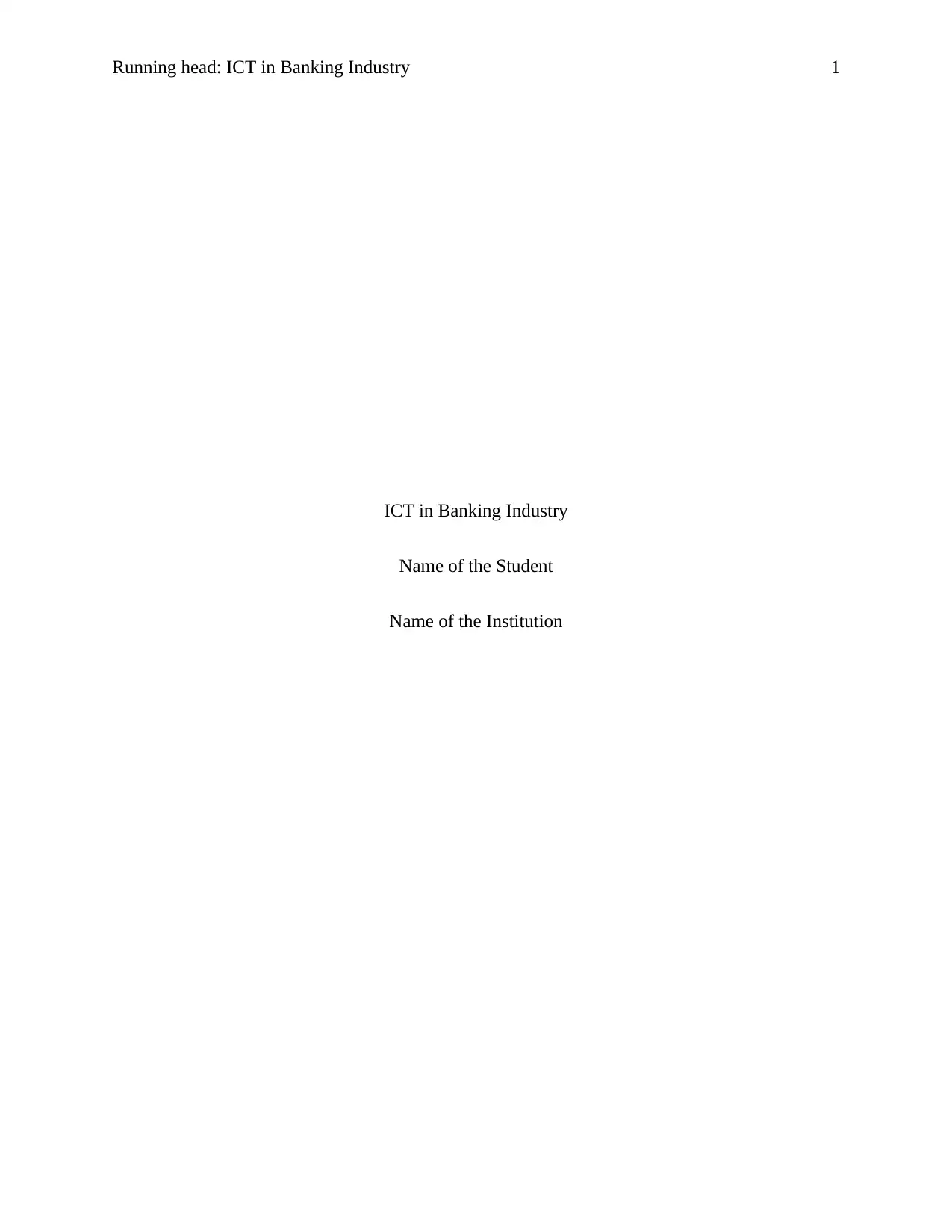
Running head: ICT in Banking Industry 1
ICT in Banking Industry
Name of the Student
Name of the Institution
ICT in Banking Industry
Name of the Student
Name of the Institution
Paraphrase This Document
Need a fresh take? Get an instant paraphrase of this document with our AI Paraphraser
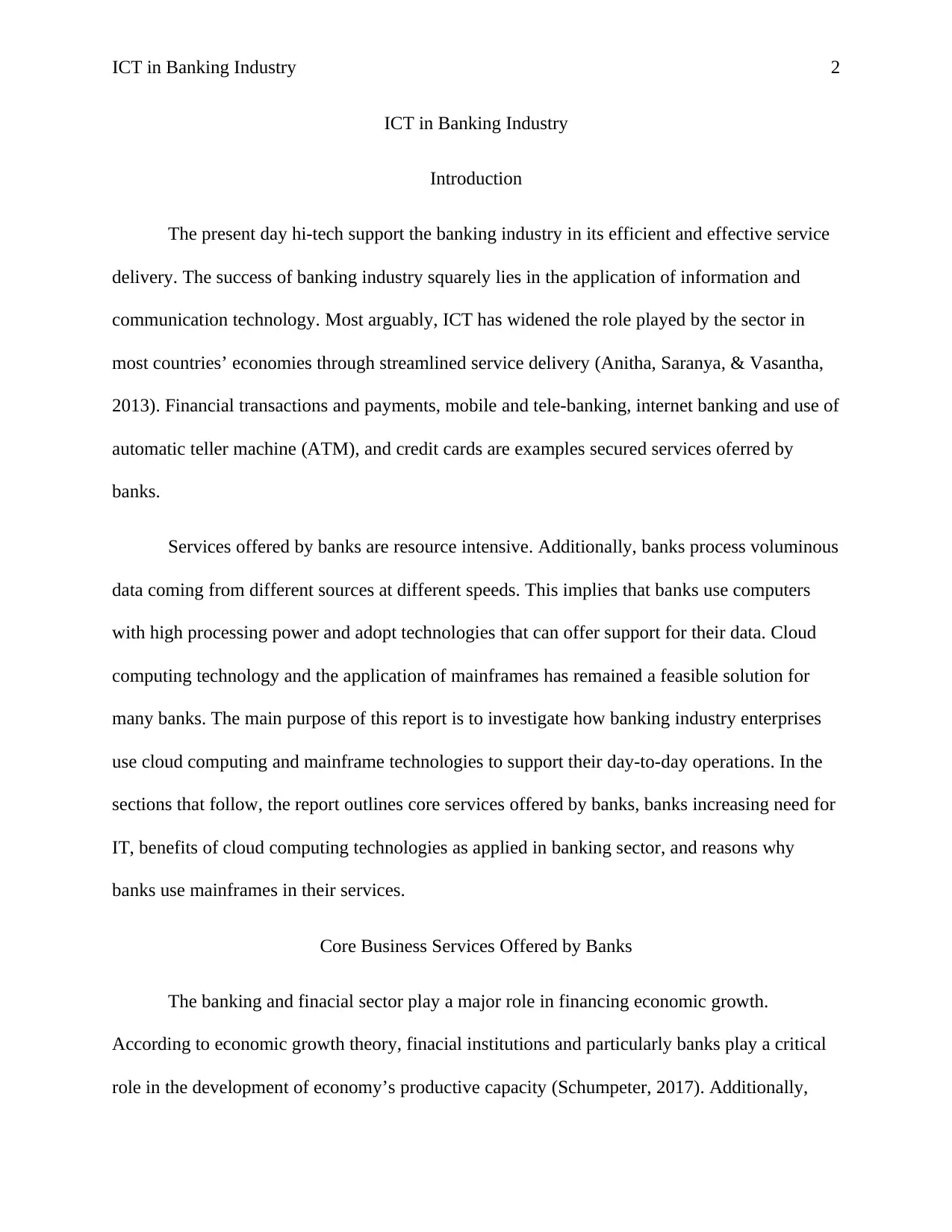
ICT in Banking Industry 2
ICT in Banking Industry
Introduction
The present day hi-tech support the banking industry in its efficient and effective service
delivery. The success of banking industry squarely lies in the application of information and
communication technology. Most arguably, ICT has widened the role played by the sector in
most countries’ economies through streamlined service delivery (Anitha, Saranya, & Vasantha,
2013). Financial transactions and payments, mobile and tele-banking, internet banking and use of
automatic teller machine (ATM), and credit cards are examples secured services oferred by
banks.
Services offered by banks are resource intensive. Additionally, banks process voluminous
data coming from different sources at different speeds. This implies that banks use computers
with high processing power and adopt technologies that can offer support for their data. Cloud
computing technology and the application of mainframes has remained a feasible solution for
many banks. The main purpose of this report is to investigate how banking industry enterprises
use cloud computing and mainframe technologies to support their day-to-day operations. In the
sections that follow, the report outlines core services offered by banks, banks increasing need for
IT, benefits of cloud computing technologies as applied in banking sector, and reasons why
banks use mainframes in their services.
Core Business Services Offered by Banks
The banking and finacial sector play a major role in financing economic growth.
According to economic growth theory, finacial institutions and particularly banks play a critical
role in the development of economy’s productive capacity (Schumpeter, 2017). Additionally,
ICT in Banking Industry
Introduction
The present day hi-tech support the banking industry in its efficient and effective service
delivery. The success of banking industry squarely lies in the application of information and
communication technology. Most arguably, ICT has widened the role played by the sector in
most countries’ economies through streamlined service delivery (Anitha, Saranya, & Vasantha,
2013). Financial transactions and payments, mobile and tele-banking, internet banking and use of
automatic teller machine (ATM), and credit cards are examples secured services oferred by
banks.
Services offered by banks are resource intensive. Additionally, banks process voluminous
data coming from different sources at different speeds. This implies that banks use computers
with high processing power and adopt technologies that can offer support for their data. Cloud
computing technology and the application of mainframes has remained a feasible solution for
many banks. The main purpose of this report is to investigate how banking industry enterprises
use cloud computing and mainframe technologies to support their day-to-day operations. In the
sections that follow, the report outlines core services offered by banks, banks increasing need for
IT, benefits of cloud computing technologies as applied in banking sector, and reasons why
banks use mainframes in their services.
Core Business Services Offered by Banks
The banking and finacial sector play a major role in financing economic growth.
According to economic growth theory, finacial institutions and particularly banks play a critical
role in the development of economy’s productive capacity (Schumpeter, 2017). Additionally,
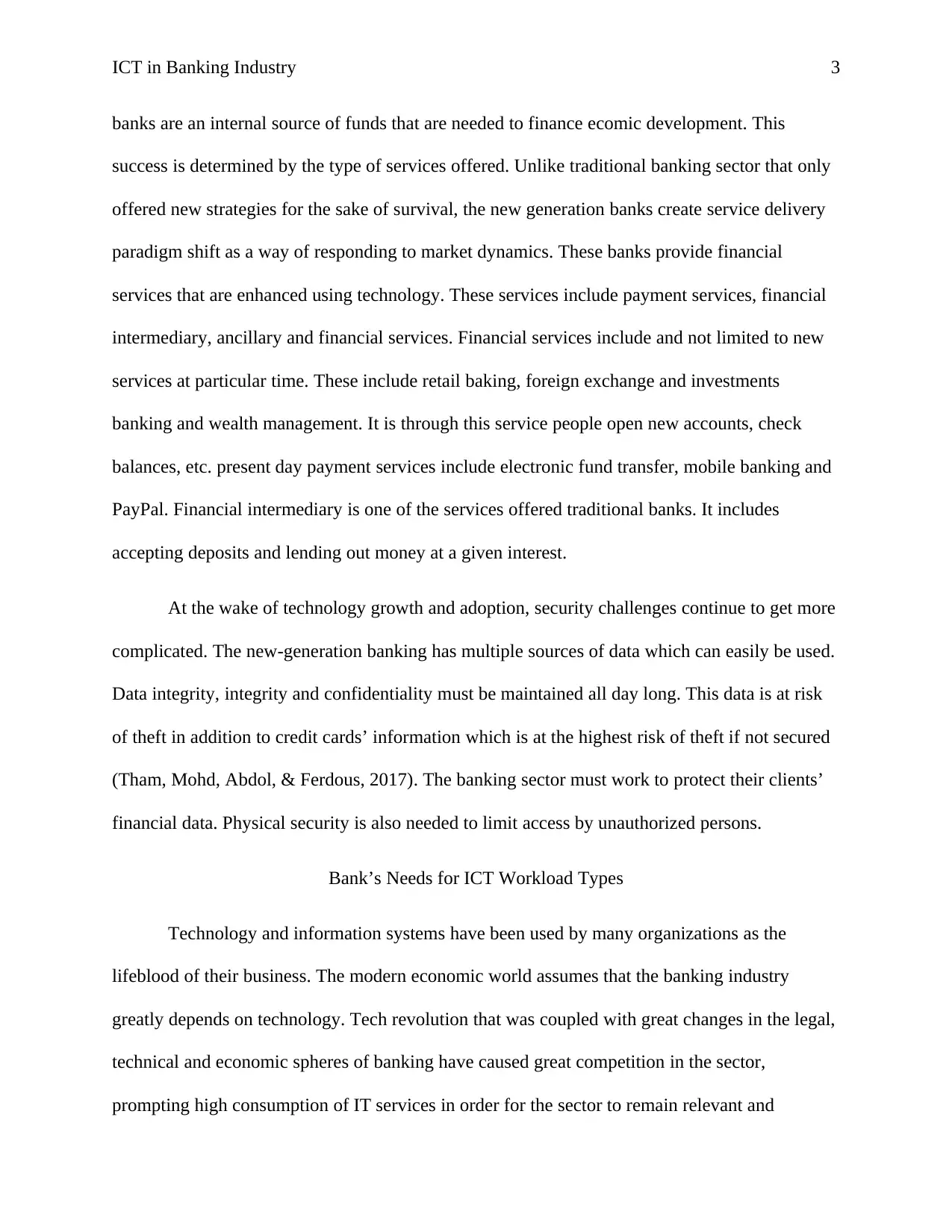
ICT in Banking Industry 3
banks are an internal source of funds that are needed to finance ecomic development. This
success is determined by the type of services offered. Unlike traditional banking sector that only
offered new strategies for the sake of survival, the new generation banks create service delivery
paradigm shift as a way of responding to market dynamics. These banks provide financial
services that are enhanced using technology. These services include payment services, financial
intermediary, ancillary and financial services. Financial services include and not limited to new
services at particular time. These include retail baking, foreign exchange and investments
banking and wealth management. It is through this service people open new accounts, check
balances, etc. present day payment services include electronic fund transfer, mobile banking and
PayPal. Financial intermediary is one of the services offered traditional banks. It includes
accepting deposits and lending out money at a given interest.
At the wake of technology growth and adoption, security challenges continue to get more
complicated. The new-generation banking has multiple sources of data which can easily be used.
Data integrity, integrity and confidentiality must be maintained all day long. This data is at risk
of theft in addition to credit cards’ information which is at the highest risk of theft if not secured
(Tham, Mohd, Abdol, & Ferdous, 2017). The banking sector must work to protect their clients’
financial data. Physical security is also needed to limit access by unauthorized persons.
Bank’s Needs for ICT Workload Types
Technology and information systems have been used by many organizations as the
lifeblood of their business. The modern economic world assumes that the banking industry
greatly depends on technology. Tech revolution that was coupled with great changes in the legal,
technical and economic spheres of banking have caused great competition in the sector,
prompting high consumption of IT services in order for the sector to remain relevant and
banks are an internal source of funds that are needed to finance ecomic development. This
success is determined by the type of services offered. Unlike traditional banking sector that only
offered new strategies for the sake of survival, the new generation banks create service delivery
paradigm shift as a way of responding to market dynamics. These banks provide financial
services that are enhanced using technology. These services include payment services, financial
intermediary, ancillary and financial services. Financial services include and not limited to new
services at particular time. These include retail baking, foreign exchange and investments
banking and wealth management. It is through this service people open new accounts, check
balances, etc. present day payment services include electronic fund transfer, mobile banking and
PayPal. Financial intermediary is one of the services offered traditional banks. It includes
accepting deposits and lending out money at a given interest.
At the wake of technology growth and adoption, security challenges continue to get more
complicated. The new-generation banking has multiple sources of data which can easily be used.
Data integrity, integrity and confidentiality must be maintained all day long. This data is at risk
of theft in addition to credit cards’ information which is at the highest risk of theft if not secured
(Tham, Mohd, Abdol, & Ferdous, 2017). The banking sector must work to protect their clients’
financial data. Physical security is also needed to limit access by unauthorized persons.
Bank’s Needs for ICT Workload Types
Technology and information systems have been used by many organizations as the
lifeblood of their business. The modern economic world assumes that the banking industry
greatly depends on technology. Tech revolution that was coupled with great changes in the legal,
technical and economic spheres of banking have caused great competition in the sector,
prompting high consumption of IT services in order for the sector to remain relevant and
⊘ This is a preview!⊘
Do you want full access?
Subscribe today to unlock all pages.

Trusted by 1+ million students worldwide
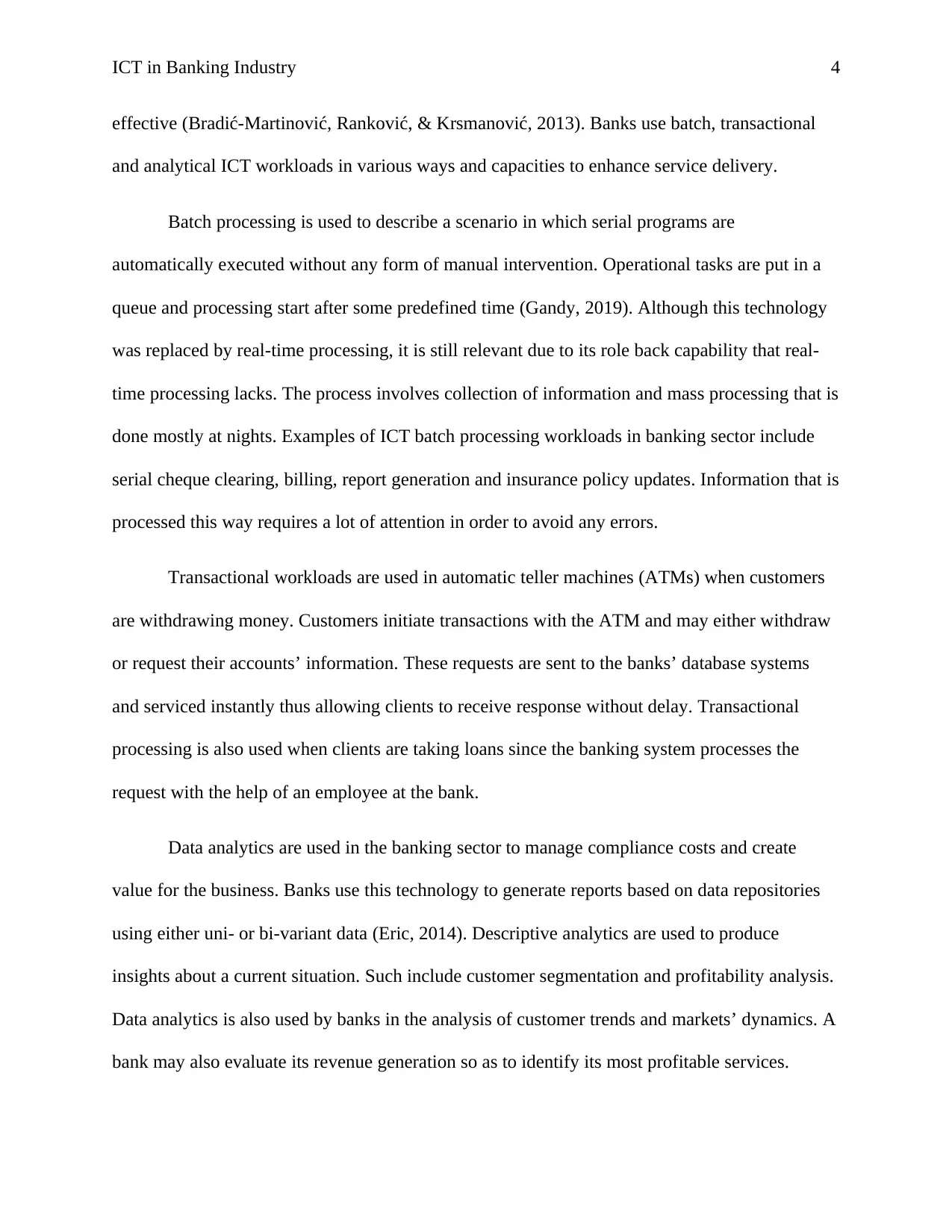
ICT in Banking Industry 4
effective (Bradić-Martinović, Ranković, & Krsmanović, 2013). Banks use batch, transactional
and analytical ICT workloads in various ways and capacities to enhance service delivery.
Batch processing is used to describe a scenario in which serial programs are
automatically executed without any form of manual intervention. Operational tasks are put in a
queue and processing start after some predefined time (Gandy, 2019). Although this technology
was replaced by real-time processing, it is still relevant due to its role back capability that real-
time processing lacks. The process involves collection of information and mass processing that is
done mostly at nights. Examples of ICT batch processing workloads in banking sector include
serial cheque clearing, billing, report generation and insurance policy updates. Information that is
processed this way requires a lot of attention in order to avoid any errors.
Transactional workloads are used in automatic teller machines (ATMs) when customers
are withdrawing money. Customers initiate transactions with the ATM and may either withdraw
or request their accounts’ information. These requests are sent to the banks’ database systems
and serviced instantly thus allowing clients to receive response without delay. Transactional
processing is also used when clients are taking loans since the banking system processes the
request with the help of an employee at the bank.
Data analytics are used in the banking sector to manage compliance costs and create
value for the business. Banks use this technology to generate reports based on data repositories
using either uni- or bi-variant data (Eric, 2014). Descriptive analytics are used to produce
insights about a current situation. Such include customer segmentation and profitability analysis.
Data analytics is also used by banks in the analysis of customer trends and markets’ dynamics. A
bank may also evaluate its revenue generation so as to identify its most profitable services.
effective (Bradić-Martinović, Ranković, & Krsmanović, 2013). Banks use batch, transactional
and analytical ICT workloads in various ways and capacities to enhance service delivery.
Batch processing is used to describe a scenario in which serial programs are
automatically executed without any form of manual intervention. Operational tasks are put in a
queue and processing start after some predefined time (Gandy, 2019). Although this technology
was replaced by real-time processing, it is still relevant due to its role back capability that real-
time processing lacks. The process involves collection of information and mass processing that is
done mostly at nights. Examples of ICT batch processing workloads in banking sector include
serial cheque clearing, billing, report generation and insurance policy updates. Information that is
processed this way requires a lot of attention in order to avoid any errors.
Transactional workloads are used in automatic teller machines (ATMs) when customers
are withdrawing money. Customers initiate transactions with the ATM and may either withdraw
or request their accounts’ information. These requests are sent to the banks’ database systems
and serviced instantly thus allowing clients to receive response without delay. Transactional
processing is also used when clients are taking loans since the banking system processes the
request with the help of an employee at the bank.
Data analytics are used in the banking sector to manage compliance costs and create
value for the business. Banks use this technology to generate reports based on data repositories
using either uni- or bi-variant data (Eric, 2014). Descriptive analytics are used to produce
insights about a current situation. Such include customer segmentation and profitability analysis.
Data analytics is also used by banks in the analysis of customer trends and markets’ dynamics. A
bank may also evaluate its revenue generation so as to identify its most profitable services.
Paraphrase This Document
Need a fresh take? Get an instant paraphrase of this document with our AI Paraphraser
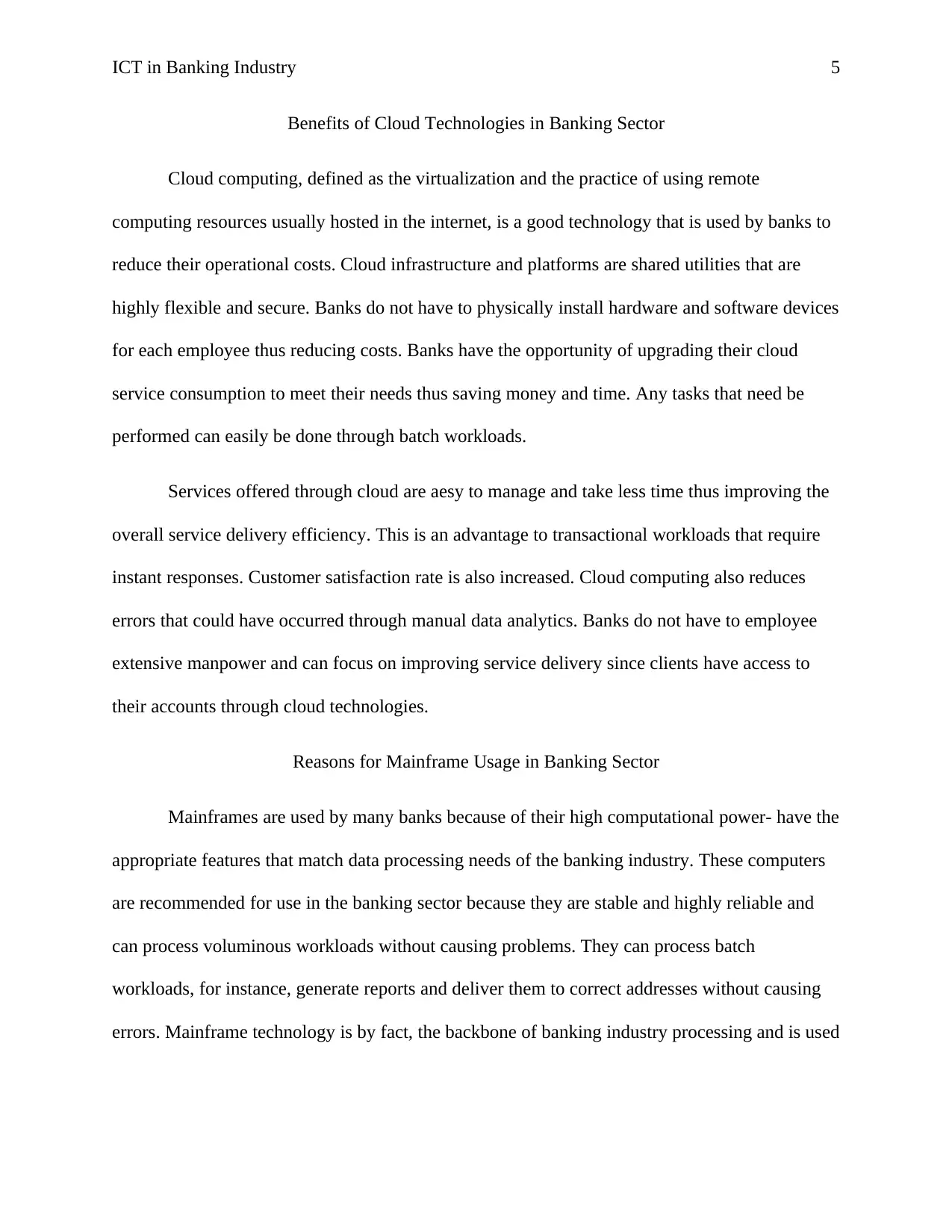
ICT in Banking Industry 5
Benefits of Cloud Technologies in Banking Sector
Cloud computing, defined as the virtualization and the practice of using remote
computing resources usually hosted in the internet, is a good technology that is used by banks to
reduce their operational costs. Cloud infrastructure and platforms are shared utilities that are
highly flexible and secure. Banks do not have to physically install hardware and software devices
for each employee thus reducing costs. Banks have the opportunity of upgrading their cloud
service consumption to meet their needs thus saving money and time. Any tasks that need be
performed can easily be done through batch workloads.
Services offered through cloud are aesy to manage and take less time thus improving the
overall service delivery efficiency. This is an advantage to transactional workloads that require
instant responses. Customer satisfaction rate is also increased. Cloud computing also reduces
errors that could have occurred through manual data analytics. Banks do not have to employee
extensive manpower and can focus on improving service delivery since clients have access to
their accounts through cloud technologies.
Reasons for Mainframe Usage in Banking Sector
Mainframes are used by many banks because of their high computational power- have the
appropriate features that match data processing needs of the banking industry. These computers
are recommended for use in the banking sector because they are stable and highly reliable and
can process voluminous workloads without causing problems. They can process batch
workloads, for instance, generate reports and deliver them to correct addresses without causing
errors. Mainframe technology is by fact, the backbone of banking industry processing and is used
Benefits of Cloud Technologies in Banking Sector
Cloud computing, defined as the virtualization and the practice of using remote
computing resources usually hosted in the internet, is a good technology that is used by banks to
reduce their operational costs. Cloud infrastructure and platforms are shared utilities that are
highly flexible and secure. Banks do not have to physically install hardware and software devices
for each employee thus reducing costs. Banks have the opportunity of upgrading their cloud
service consumption to meet their needs thus saving money and time. Any tasks that need be
performed can easily be done through batch workloads.
Services offered through cloud are aesy to manage and take less time thus improving the
overall service delivery efficiency. This is an advantage to transactional workloads that require
instant responses. Customer satisfaction rate is also increased. Cloud computing also reduces
errors that could have occurred through manual data analytics. Banks do not have to employee
extensive manpower and can focus on improving service delivery since clients have access to
their accounts through cloud technologies.
Reasons for Mainframe Usage in Banking Sector
Mainframes are used by many banks because of their high computational power- have the
appropriate features that match data processing needs of the banking industry. These computers
are recommended for use in the banking sector because they are stable and highly reliable and
can process voluminous workloads without causing problems. They can process batch
workloads, for instance, generate reports and deliver them to correct addresses without causing
errors. Mainframe technology is by fact, the backbone of banking industry processing and is used

ICT in Banking Industry 6
alongside cloud computing technologies as host machine for cloud services. They may also be
used as backups for the voluminous data generated in the banking sector.
Video Transcript
Information, communication and technology continues to play a critical role in the
banking industry, helping it to widen its roles in the economic development through streamlined
services. IT service consumption and adoption in the sector is influenced the huge computational
and processing power requirements. At the advent of big data and widespread IT consumption,
mainframe computers coupled with cloud computing sit at the core of banks’ ICT infrastructure.
Most unfortunately, data confidentiality, integrity and availability of services still continues to
hover over the sector.
Major services offered by the sector include payments services, financial intermediary,
ancillary and financial services. Financial services include and not limited to new services at
particular time. These include retail baking, foreign exchange and investments banking and
wealth management. It is through this service people open new accounts, check balances, etc.
present day payment services include electronic fund transfer, mobile banking and PayPal.
Financial intermediary is one of the services offered by traditional banks. It includes accepting
deposits and lending out money at a given interest.
Workloads that prompt usage of ICT are batch, transactional and analytical processes.
Batch processes are serial programs that are automatically executed without any form of manual
intervention. Operational tasks are put in a queue and processing start after some predefined
time. Real-time processing replaced batch processing although it is still in use due to its roll back
capability. Report generation, billing, serial cheque clearing and insurance policy updates
alongside cloud computing technologies as host machine for cloud services. They may also be
used as backups for the voluminous data generated in the banking sector.
Video Transcript
Information, communication and technology continues to play a critical role in the
banking industry, helping it to widen its roles in the economic development through streamlined
services. IT service consumption and adoption in the sector is influenced the huge computational
and processing power requirements. At the advent of big data and widespread IT consumption,
mainframe computers coupled with cloud computing sit at the core of banks’ ICT infrastructure.
Most unfortunately, data confidentiality, integrity and availability of services still continues to
hover over the sector.
Major services offered by the sector include payments services, financial intermediary,
ancillary and financial services. Financial services include and not limited to new services at
particular time. These include retail baking, foreign exchange and investments banking and
wealth management. It is through this service people open new accounts, check balances, etc.
present day payment services include electronic fund transfer, mobile banking and PayPal.
Financial intermediary is one of the services offered by traditional banks. It includes accepting
deposits and lending out money at a given interest.
Workloads that prompt usage of ICT are batch, transactional and analytical processes.
Batch processes are serial programs that are automatically executed without any form of manual
intervention. Operational tasks are put in a queue and processing start after some predefined
time. Real-time processing replaced batch processing although it is still in use due to its roll back
capability. Report generation, billing, serial cheque clearing and insurance policy updates
⊘ This is a preview!⊘
Do you want full access?
Subscribe today to unlock all pages.

Trusted by 1+ million students worldwide
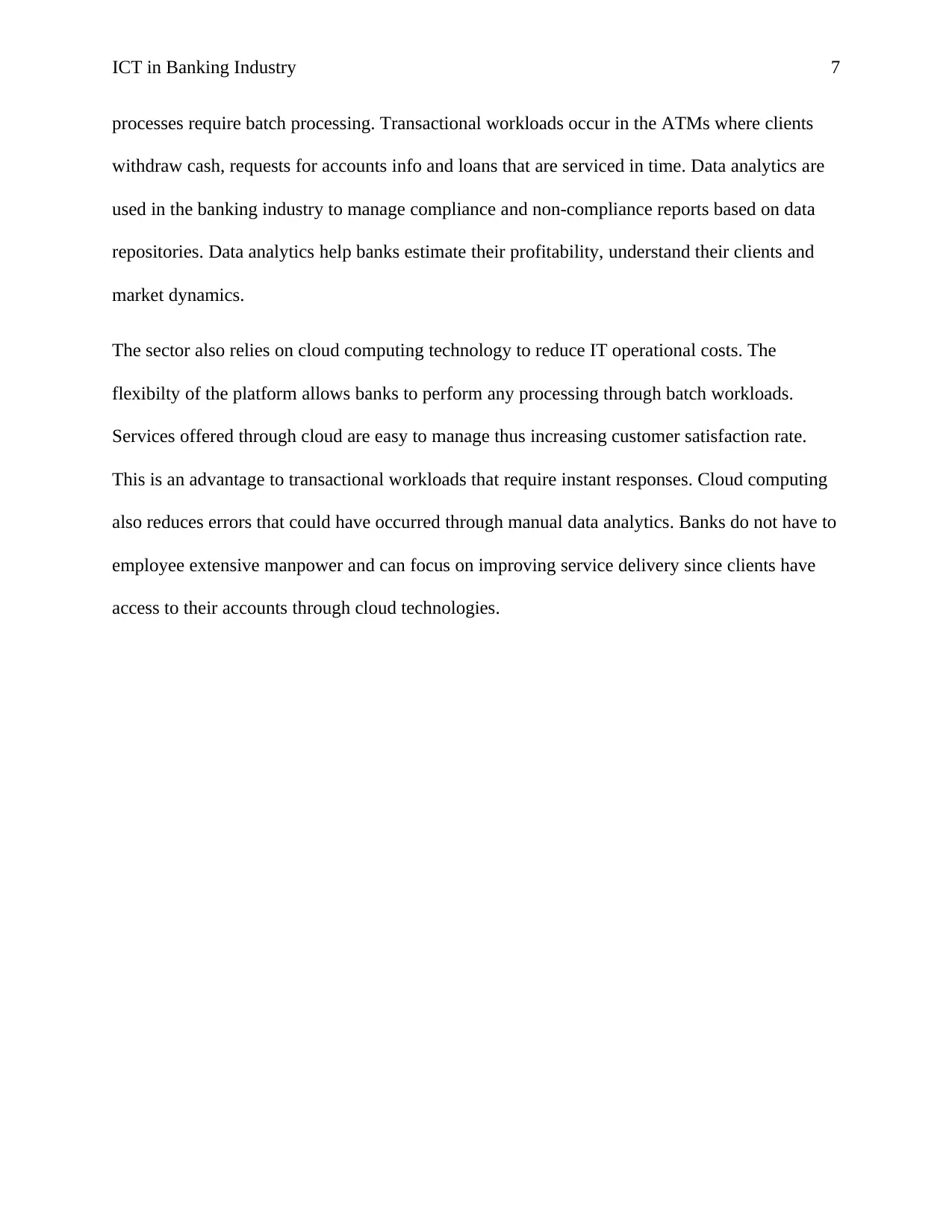
ICT in Banking Industry 7
processes require batch processing. Transactional workloads occur in the ATMs where clients
withdraw cash, requests for accounts info and loans that are serviced in time. Data analytics are
used in the banking industry to manage compliance and non-compliance reports based on data
repositories. Data analytics help banks estimate their profitability, understand their clients and
market dynamics.
The sector also relies on cloud computing technology to reduce IT operational costs. The
flexibilty of the platform allows banks to perform any processing through batch workloads.
Services offered through cloud are easy to manage thus increasing customer satisfaction rate.
This is an advantage to transactional workloads that require instant responses. Cloud computing
also reduces errors that could have occurred through manual data analytics. Banks do not have to
employee extensive manpower and can focus on improving service delivery since clients have
access to their accounts through cloud technologies.
processes require batch processing. Transactional workloads occur in the ATMs where clients
withdraw cash, requests for accounts info and loans that are serviced in time. Data analytics are
used in the banking industry to manage compliance and non-compliance reports based on data
repositories. Data analytics help banks estimate their profitability, understand their clients and
market dynamics.
The sector also relies on cloud computing technology to reduce IT operational costs. The
flexibilty of the platform allows banks to perform any processing through batch workloads.
Services offered through cloud are easy to manage thus increasing customer satisfaction rate.
This is an advantage to transactional workloads that require instant responses. Cloud computing
also reduces errors that could have occurred through manual data analytics. Banks do not have to
employee extensive manpower and can focus on improving service delivery since clients have
access to their accounts through cloud technologies.
Paraphrase This Document
Need a fresh take? Get an instant paraphrase of this document with our AI Paraphraser
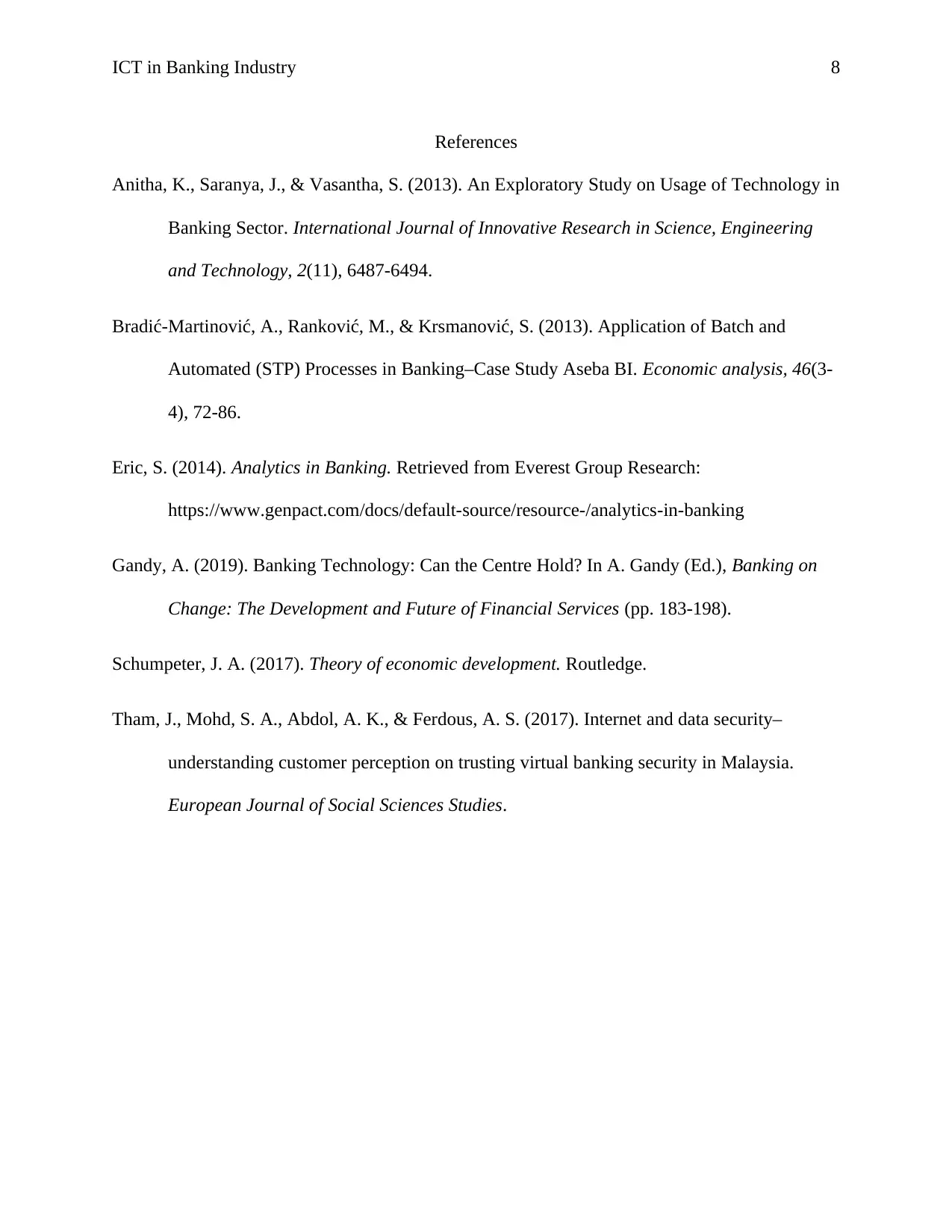
ICT in Banking Industry 8
References
Anitha, K., Saranya, J., & Vasantha, S. (2013). An Exploratory Study on Usage of Technology in
Banking Sector. International Journal of Innovative Research in Science, Engineering
and Technology, 2(11), 6487-6494.
Bradić-Martinović, A., Ranković, M., & Krsmanović, S. (2013). Application of Batch and
Automated (STP) Processes in Banking–Case Study Aseba BI. Economic analysis, 46(3-
4), 72-86.
Eric, S. (2014). Analytics in Banking. Retrieved from Everest Group Research:
https://www.genpact.com/docs/default-source/resource-/analytics-in-banking
Gandy, A. (2019). Banking Technology: Can the Centre Hold? In A. Gandy (Ed.), Banking on
Change: The Development and Future of Financial Services (pp. 183-198).
Schumpeter, J. A. (2017). Theory of economic development. Routledge.
Tham, J., Mohd, S. A., Abdol, A. K., & Ferdous, A. S. (2017). Internet and data security–
understanding customer perception on trusting virtual banking security in Malaysia.
European Journal of Social Sciences Studies.
References
Anitha, K., Saranya, J., & Vasantha, S. (2013). An Exploratory Study on Usage of Technology in
Banking Sector. International Journal of Innovative Research in Science, Engineering
and Technology, 2(11), 6487-6494.
Bradić-Martinović, A., Ranković, M., & Krsmanović, S. (2013). Application of Batch and
Automated (STP) Processes in Banking–Case Study Aseba BI. Economic analysis, 46(3-
4), 72-86.
Eric, S. (2014). Analytics in Banking. Retrieved from Everest Group Research:
https://www.genpact.com/docs/default-source/resource-/analytics-in-banking
Gandy, A. (2019). Banking Technology: Can the Centre Hold? In A. Gandy (Ed.), Banking on
Change: The Development and Future of Financial Services (pp. 183-198).
Schumpeter, J. A. (2017). Theory of economic development. Routledge.
Tham, J., Mohd, S. A., Abdol, A. K., & Ferdous, A. S. (2017). Internet and data security–
understanding customer perception on trusting virtual banking security in Malaysia.
European Journal of Social Sciences Studies.
1 out of 8
Related Documents
Your All-in-One AI-Powered Toolkit for Academic Success.
+13062052269
info@desklib.com
Available 24*7 on WhatsApp / Email
![[object Object]](/_next/static/media/star-bottom.7253800d.svg)
Unlock your academic potential
Copyright © 2020–2025 A2Z Services. All Rights Reserved. Developed and managed by ZUCOL.





